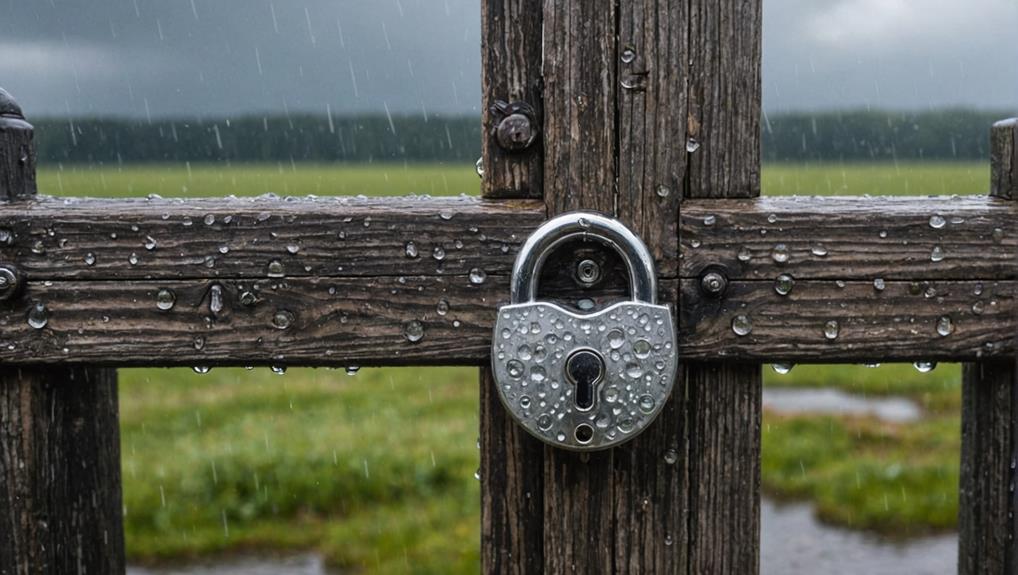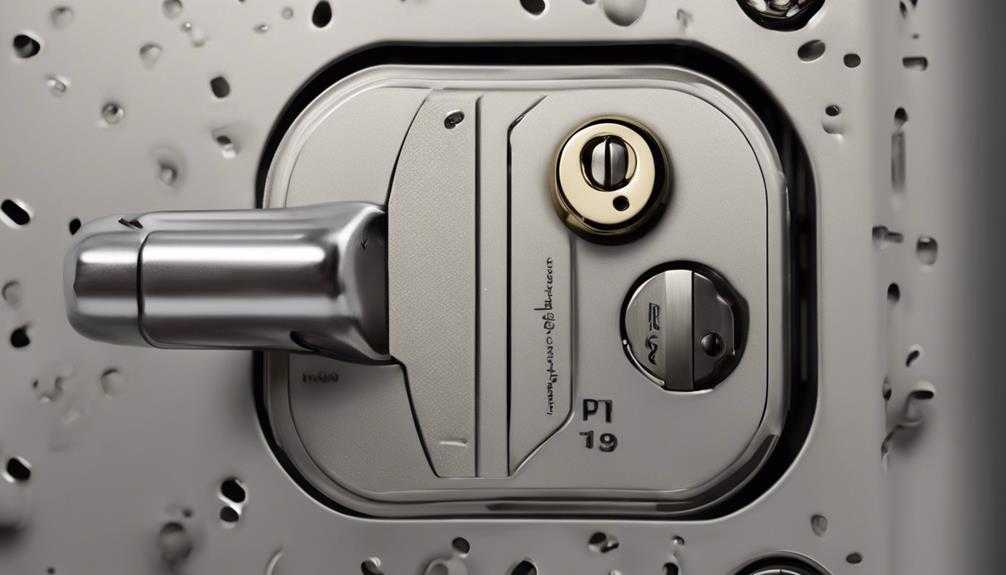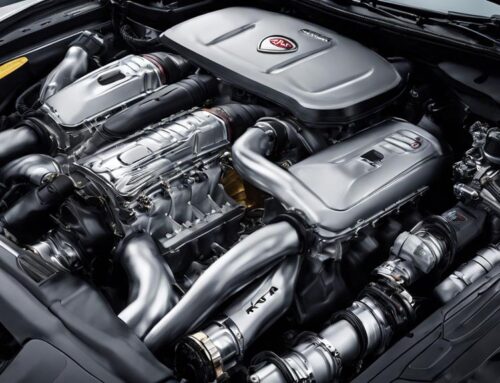Choosing a high-security lock guarantees top-notch protection for your assets. Look for locks with complex keyways that resist picking, reinforced bolts for added strength, and anti-drill plates to thwart drilling attempts. These locks also feature bump-proof technology to prevent lock bumping and may include tamper-evident features to signal unauthorized access. Low-maintenance weather resistance ensures durability in various conditions. Always check for certifications like UL 437 or ANSI/BHMA that guarantee high-security standards. With these features, you'll find the peace of mind you're looking for in lock security. There's much more to discover about safeguarding your property.
Key Takeaways
- Complex keyways with intricate designs enhance protection against unauthorized entry and lock picking.
- Pick-resistant mechanisms, including security pins and sidebars, thwart lock-picking attempts.
- Bump-proof technology defends against lock bumping through advanced pin configurations and electronic elements.
- Key control systems restrict key duplication and access to authorized personnel only.
- Certifications like UL 437 and ANSI/BHMA A156.30 ensure the lock's resistance to advanced physical attacks.
Complex Keyways

When it comes to high-security locks, complex keyways play an essential role in enhancing protection against unauthorized entry. You want to help others feel safe, and understanding how complex keyways contribute to security can empower you to make better choices.
These intricate designs make it incredibly difficult for lock pickers to manipulate the internal mechanisms. According to a recent comparative analysis, high-security locks are more effective at deterring break-ins compared to standard locks.
Advanced lock designs incorporate complex keyways, adding multiple layers of security. When you choose a lock with a complex keyway, you're opting for a product designed to withstand various intrusion techniques.
These keyways often feature unique shapes and additional pins, making it almost impossible for standard tools to bypass them. This means you're providing a higher level of safety for those you serve.
Secure lock materials also come into play. High-quality materials guarantee that the intricate components of these advanced designs remain robust and long-lasting.
When selecting secure lock materials, you guarantee that the lock can resist physical attacks and wear over time. By focusing on complex keyways and advanced lock designs, you're prioritizing the well-being of those who rely on you for security.
Hardened Steel Construction

Hardened steel construction is a cornerstone of high-security locks, providing unmatched durability and strength. When you're looking to protect the ones you serve, understanding high-security lock features is essential.
Hardened steel resists cutting, sawing, and other forms of physical attack, making it a critical element in what makes a lock secure.
Imagine a lock that can withstand the most persistent attempts to break it. That's the power of hardened steel construction. This material undergoes a special process that increases its hardness and toughness, creating a barrier that's incredibly difficult to breach.
For anyone committed to serving others, choosing a lock with hardened steel construction means you're prioritizing their safety and peace of mind.
High-security lock features often include this robust material because it adds a layer of protection that's hard for intruders to overcome.
When you're weighing what makes a lock secure, remember that the strength of the construction material can make all the difference.
Anti-Drill Plates

Anti-drill plates are another essential feature of high-security locks, designed to thwart attempts at forced entry using drills. When you're choosing a lock to protect what matters most, understanding how these plates work can make all the difference.
They're typically made from hardened steel and are strategically placed to cover vulnerable areas of the lock's mechanism. This high-security technology guarantees that any attempt to drill through the lock is met with extreme resistance, often breaking the drill bit before it can penetrate.
For those interested in residential use, these plates are a vital addition to any home security system.
In comparing high-security locks vs standard locks, anti-drill plates stand out as a significant distinction. Standard locks often lack this feature, making them an easier target for intruders.
High-security locks incorporate these plates as a fundamental part of their design, adding an extra layer of protection. When you help others by recommending lock features that offer real security, mentioning anti-drill plates can greatly influence their decision.
Pick-Resistant Mechanisms

Pick-resistant mechanisms are a cornerstone of high-security locks, offering robust protection against lock-picking attempts.
When you're helping others secure their homes or businesses, understanding these features is vital.
Protecting residential properties from break-ins requires a multi-layered approach, and high-security locks are a key component.
Here are four key elements to look for:
- Complex Keyways: High-security locks often have intricate keyways, making it difficult for unauthorized tools to maneuver inside. This complexity guarantees only the correct key can operate the lock.
- Security Pins: Locks equipped with spool, mushroom, or serrated pins can thwart picking attempts. These specially designed pins create false feedback for the picker, leading them astray and preventing unauthorized entry.
- Sidebars and Tumbler Systems: Some high-security locks use additional sidebars or secondary tumbler systems. These components add another layer of difficulty, requiring precision alignment that simple picking tools can't easily achieve.
- Magnetic Elements: Incorporating magnetic elements into the lock mechanism can further deter picking. These elements interact with specific magnets in the key, adding an extra layer of security that's tough to bypass.
Bump-Proof Technology

When it comes to securing your home or business, bump-proof technology offers a formidable line of defense against lock bumping—a common and quick method used by intruders. Lock bumping involves using a specially cut key to manipulate the pins inside a lock, allowing unauthorized access within seconds. You want to make certain that those you care about and serve are safe from such easy break-ins.
By investing in bump-proof locks, you're taking a proactive step to protect your space. These locks are engineered with advanced pin configurations and additional security pins that make bumping nearly impossible. It's not just about the physical components; some bump-proof locks also incorporate electronic elements to further safeguard against tampering.
Because high-security locks are vital for protecting residential properties from break-ins, they offer an added layer of protection that's critical in today's security landscape.
When selecting a bump-proof lock, look for certifications from recognized security organizations, like ANSI or UL. These certifications guarantee the lock has been rigorously tested and meets high-security standards. Additionally, some manufacturers offer locks with patented keyways, which prevent unauthorized key duplication.
Incorporating bump-proof technology into your security plan is a tangible way to serve others by creating a safer environment. Your commitment to security can provide peace of mind to everyone who enters your home or business.
Key Control Systems

When you consider key control systems, you're focusing on restricted key access and preventing unauthorized duplication.
These systems guarantee only authorized personnel can access specific keys, enhancing security. By limiting who can copy keys, you greatly reduce the risk of breaches.
Additionally, some high-security locks, like those featured in top high-security locks, incorporate advanced technology to further bolster protection.
These enhancements make it even harder for unauthorized individuals to bypass the security measures in place.
Restricted Key Access
Restricted key access is a cornerstone of high-security locks, ensuring that only authorized individuals can duplicate or use specific keys.
When you're looking to serve others by securing their homes or businesses, understanding this feature is essential. Restricted key access means the keys aren't readily available at any hardware store; only certain locksmiths or manufacturers can produce them.
This control system provides peace of mind and enhances security. Here's what to look for:
- Patent Protection: Keys should have patents, preventing unauthorized duplication.
- Unique Keyways: Look for unique keyways that are specifically designed for your lock system.
- Identification Requirements: Access to key duplication should require proper identification and authorization.
- Key Registration: Register the keys with the manufacturer, ensuring a record of all duplicates.
Key Duplication Prevention
Key duplication prevention is a critical component of high-security locks, often implemented through sophisticated key control systems. When you're looking to protect what matters most, unauthorized key copying can be a major vulnerability. High-security locks combat this by incorporating patented keyways and restricted key blanks, which means only authorized dealers can produce duplicates.
Imagine you've entrusted someone with a key, confident that it can't be easily copied at a local hardware store. This peace of mind is invaluable, especially when you're responsible for safeguarding sensitive areas like hospitals, schools, or community centers. By using a key control system, you guarantee that each key is accounted for and can only be duplicated with proper authorization.
Moreover, these systems often include unique identification codes or security cards that further restrict duplication. You're fundamentally putting another lock on the process of creating a copy, making it considerably harder for unauthorized persons to gain access.
This level of control is crucial when your priority is to serve and protect others. So, when evaluating high-security locks, don't overlook the importance of robust key duplication prevention measures. They're a game-changer in maintaining the integrity of your security system.
Reinforced Bolts

Over the years, reinforced bolts have become a cornerstone in the design of high-security locks. If you're looking to enhance the security of a property you're responsible for, understanding the importance of reinforced bolts is essential.
Choosing the right locks involves more than just selecting a brand; it's about knowing the components that offer the best protection. These components offer an extra layer of protection by making it considerably harder for intruders to force entry.
Here are four key attributes to look for in reinforced bolts:
- Material Strength: High-quality reinforced bolts are typically made from hardened steel or other durable materials that resist cutting, sawing, and drilling.
- Bolt Size: The length and diameter of the bolt can add to its strength. Thicker and longer bolts provide better resistance against physical attacks.
- Bolt Throw: This refers to the distance the bolt travels into the door frame when locked. A longer throw means the bolt penetrates deeper, making it harder to jimmy the lock.
- Design Integration: Reinforced bolts should seamlessly integrate with the lock mechanism, ensuring smooth operation without compromising security.
Tamper-Evident Features

When you choose high-security locks, you'll want to look for tamper-evident features like visible tamper seals.
These seals can show if someone has tried to interfere with the lock. For a step-by-step guide on installation, visit Secure Your Home.
Additionally, anti-drill components can prevent unauthorized access by making drilling attempts futile.
Visible Tamper Seals
Visible tamper seals play an essential role in enhancing the security of high-security locks. When you're aiming to protect something valuable, you want to guarantee that any unauthorized attempts to access it are immediately noticeable.
Tamper-evident features are designed to show visible signs if someone tries to tamper with the lock, providing you with peace of mind and a clear indication of a breach.
Here's what to look for in quality tamper-evident features:
- Seals and Stickers: Use seals and stickers that leave behind a residue or pattern when removed. This makes it clear if the lock has been tampered with.
- Color-Changing Indicators: Some tamper seals change color if tampered with, offering a quick visual cue that something's not right.
- Unique Serial Numbers: Employ seals with unique serial numbers to guarantee they haven't been swapped out with an identical-looking seal.
- Breakaway Components: Look for seals that break apart when tampered with, making it impossible to reseal without obvious signs of interference.
Anti-Drill Components
Beyond visible tamper seals, high-security locks also rely on anti-drill components to thwart unauthorized access attempts. When you're responsible for safeguarding important assets or guaranteeing the safety of a community, it's essential to understand how these features work.
Anti-drill components are specially designed parts within the lock that prevent drilling—a common method used by intruders. These components often include hardened steel inserts and rotating pins. If someone tries to drill the lock, these parts will either break the drill bit or spin freely, making it nearly impossible to penetrate the lock.
Additionally, some locks feature drill-resistant plates that cover the lock cylinder. These plates are incredibly tough and require specialized, high-powered tools to even attempt penetration. By incorporating these elements, high-security locks guarantee that even determined attackers are met with significant resistance.
As someone dedicated to serving others, understanding and investing in locks with anti-drill components can offer peace of mind to those who rely on you. It's not just about keeping intruders out; it's about showing that you take their security seriously.
Weather Resistance

Weather resistance is an important factor to take into account when choosing high-security locks, especially if they're exposed to the elements.
If you're installing a lock on an exterior door, gate, or outdoor storage unit, you want it to withstand various weather conditions. According to a guide on selecting the best lock for your home's front door security, securing durability against weather extremes is essential.
Here are four key features to look for:
- Corrosion Resistance: Confirm the lock materials, such as stainless steel or brass, resist rust. This is critical for longevity and reliable performance in damp or salty environments.
- Waterproof Seals: Look for locks with rubber gaskets or other waterproofing features to prevent water from seeping into the internal mechanisms. This helps maintain functionality during heavy rain or snow.
- Temperature Tolerance: High-security locks should operate smoothly in extreme temperatures, both hot and cold. Check the manufacturer's specifications to see the temperature range the lock can handle without compromising security.
- UV Protection: Prolonged exposure to the sun can degrade materials and weaken locks. Opt for locks with UV-resistant coatings to extend their lifespan and maintain their integrity.
Certifications and Standards

When choosing high-security locks, you should look for industry-recognized certifications that guarantee quality.
These locks must comply with stringent standards, ensuring they meet rigorous testing and validation processes.
Understanding these certifications can help you make informed decisions about securing your property.
Industry-Recognized Certifications
For high-security locks, industry-recognized certifications and standards are essential in guaranteeing quality and reliability.
When you're choosing locks for maximum security, look for certifications that validate the lock's performance under rigorous testing. These certifications not only provide peace of mind but also guarantee that you're offering the best protection to those you serve.
Consider the following key certifications:
- UL 437 Certification: This guarantees the lock can resist physical attacks, including drilling, picking, and other forms of forced entry. It's a gold standard for high-security locks.
- ANSI/BHMA A156.30: This certification covers high-security cylinders and is a proof of the lock's ability to withstand advanced attacks.
- EN 1303: A European standard that focuses on durability, strength, and resistance to unauthorized access, guaranteeing the lock performs well under various conditions.
- CEN Grade: This grading system measures the lock's performance on a scale, with Grade 6 being the highest for security.
Compliance With Standards
Guaranteeing compliance with recognized standards is essential when selecting high-security locks. As someone who values serving others, you understand the importance of providing reliable security. High-security locks that meet established standards guarantee a higher level of protection for those you care about.
Look for locks that comply with standards set by recognized organizations like the American National Standards Institute (ANSI) and the Builders Hardware Manufacturers Association (BHMA). These standards guarantee that the locks have been rigorously evaluated for durability and resistance to tampering.
For instance, ANSI/BHMA Grade 1 locks are considered top-tier, offering the highest level of security.
Additionally, consider locks that meet international standards such as the European Norm (EN) ratings. EN 1303 and EN 12209 standards are well-regarded in the industry, guaranteeing that the locks provide robust security features.
Testing and Validation
Selecting locks that comply with recognized standards is just the beginning. To guarantee you're truly providing security to those you serve, you've got to look at how thoroughly these locks are tested and validated. A lock's certification is only as good as the testing it undergoes.
Here's what you should look for:
- Third-Party Testing: Independent labs, like UL (Underwriters Laboratories) or BHMA (Builders Hardware Manufacturers Association), rigorously test locks. Their unbiased results give you confidence in the lock's performance.
- Attack Resistance: Verify the lock is tested against various methods of forced entry, such as picking, drilling, and bumping. High-security locks should withstand these attacks much longer than standard locks.
- Environmental Durability: Consider locks tested for extreme weather conditions. These tests confirm the lock will function reliably in rain, snow, humidity, and temperature extremes.
- Cycle Testing: A high-security lock should endure thousands of locking and releasing cycles without failing. This simulates years of daily use to guarantee longevity.
Frequently Asked Questions
How Often Should High-Security Locks Be Maintained?
You should maintain high-security locks at least once a year.
Regular maintenance guarantees they function smoothly and remain reliable for those relying on your security measures.
By checking for wear, lubricating moving parts, and guaranteeing proper alignment, you're showing care and diligence in your service.
Don't wait for problems to arise; proactive attention helps you provide the best security and peace of mind for everyone you serve.
Can High-Security Locks Be Used on Sliding Doors?
Yes, you can definitely use high-security locks on sliding doors.
It's important to make certain that your clients feel safe and secure, no matter the type of entry.
Look for locks specifically designed for sliding doors, which often include reinforced bars or advanced locking mechanisms.
By recommending these high-security options, you're providing peace of mind and enhancing the overall security of their homes or businesses.
Always prioritize their safety and satisfaction.
Are High-Security Locks Compatible With Smart Home Systems?
Yes, high-security locks are compatible with smart home systems.
You can find many high-security locks that integrate seamlessly with your smart home devices, providing both physical security and digital convenience.
By using these locks, you'll be able to control access remotely and monitor your home more effectively.
It's a great way to guarantee your loved ones and property are safe while enjoying the benefits of modern technology.
What Is the Average Lifespan of a High-Security Lock?
You're wondering about the average lifespan of a high-security lock. Typically, these locks last around 10 to 15 years, depending on usage and environmental factors.
To best serve your clients, you should recommend regular maintenance and checkups to guarantee peak performance. By keeping an eye on wear and tear, you can help extend the lock's longevity and provide peace of mind to those you're looking to protect.
How Do High-Security Locks Impact Home Insurance Premiums?
High-security locks can positively impact your home insurance premiums by reducing them.
Insurers often see these locks as better protection against break-ins, which means less risk for them.
By installing such locks, you're not only safeguarding your home but also potentially lowering your insurance costs.
It's a win-win situation where you're serving your family's safety and saving money in the process.
Always check with your insurer for specifics.
Conclusion
When choosing a high-security lock, focus on key features like complex keyways, hardened steel construction, and anti-drill plates. Look for pick-resistant mechanisms, bump-proof technology, and reinforced bolts. Tamper-evident features and weather resistance add extra layers of protection. Don't forget to check for certifications and standards to guarantee superior security. By prioritizing these elements, you'll greatly enhance the safety of your property. Remember, a good lock is your first line of defense.









